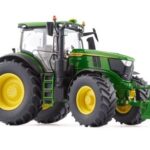Comprehensive Tractor Maintenance Tips Ensuring Longevity and Efficiency

In today’s agricultural world, tractors are essential tools for every job. They have the strength and adaptability to do everything from planting and ploughing to harvesting and moving. For your tractor to operate at its best, avoid expensive repairs, and last longer, it needs to be well-maintained. We’ll go over specific tractor maintenance advice in this post to assist you maintain your equipment operating efficiently all year long.
Regular Engine Maintenance
A. Oil Changes
- Frequency: Change the engine oil every 100-200 hours of operation or as recommended by the manufacturer.
- Procedure: Warm up the engine, then drain the old oil. Replace the oil filter and refill with the manufacturer-recommended oil type and quantity.
B. Air Filter Cleaning/Replacement
- Importance: A clean air filter ensures efficient combustion and prevents dust from entering the engine.
- Frequency: Check and clean the air filter every 50 hours. Replace it if it’s excessively dirty or damaged.
C. Fuel System Maintenance
- Fuel Filter: Replace the fuel filter every 200-400 hours. Ensure the fuel tank is clean to prevent contamination.
- Fuel Quality: Use high-quality fuel and consider adding fuel stabilizers to prevent clogging and ensure smooth operation.
Cooling System Care
A. Radiator Maintenance
- Inspection: Regularly check the radiator for debris and clogs.
- Cleaning: Use a soft brush or compressed air to remove dirt and debris. Ensure the radiator fins are straight and undamaged.
B. Coolant Levels
- Check: Inspect coolant levels before each use.
- Replacement: Flush and replace coolant every 1-2 years to prevent corrosion and overheating.
Transmission and Hydraulics
A. Transmission Fluid
- Check Levels: Regularly check transmission fluid levels and top up as necessary.
- Change Fluid: Replace transmission fluid according to the manufacturer’s guidelines, typically every 500-1,000 hours.
B. Hydraulic System
- Fluid Levels: Check hydraulic fluid levels frequently.
- Filter Replacement: Replace hydraulic filters as recommended, usually every 500 hours.
- Hose Inspection: Regularly inspect hydraulic hoses for leaks, cracks, or wear. Replace damaged hoses immediately.
Tire and Wheel Maintenance
A. Tire Pressure
- Check Regularly: Maintain proper tire pressure to ensure optimal traction and fuel efficiency.
- Adjust for Load: Adjust tire pressure based on the load and terrain to avoid unnecessary wear.
B. Tire Condition
- Inspect: Regularly inspect tires for cuts, punctures, or uneven wear.
- Rotate Tires: Rotate tires periodically to ensure even wear.
Electrical System
A. Battery Maintenance
- Clean Terminals: Keep battery terminals clean and free from corrosion.
- Check Charge: Ensure the battery is fully charged and inspect it for any signs of damage or wear.
B. Wiring and Connections
- Inspect: Regularly check all electrical connections and wiring for wear or damage.
- Secure Connections: Ensure all connections are tight and secure.
Implement and Attach Care
A. Inspection and Lubrication
- Inspect: Regularly inspect all implements and attachments for damage or wear.
- Lubricate: Lubricate moving parts as per the manufacturer’s instructions to prevent rust and ensure smooth operation.
B. Secure Attachment
- Check Connections: Ensure all attachments are securely connected to the tractor.
- Proper Use: Use attachments correctly to avoid unnecessary strain on the tractor.
Safety Checks
A. Lights and Indicators
- Functionality: Regularly check all lights and indicators to ensure they are functioning correctly.
- Clean Lenses: Keep light lenses clean to ensure maximum visibility.
B. Brakes and Steering
- Brake Check: Test brakes regularly to ensure they are responsive.
- Steering Inspection: Check steering components for wear and ensure they operate smoothly.
Seasonal Maintenance
A. Winterization
- Fuel Additives: Use fuel additives to prevent fuel gelling in cold weather.
- Battery Care: Keep the battery charged and consider using a battery heater.
- Fluid Levels: Check and adjust all fluid levels to prevent freezing.
B. Summer Preparation
- Cooling System: Ensure the cooling system is in top condition to prevent overheating.
- Air Conditioning: If equipped, ensure the air conditioning system is working correctly.
Regular Inspections
A. Daily Checks
- Fluids: Check oil, coolant, and hydraulic fluid levels before each use.
- Tires: Inspect tire pressure and condition.
- General Condition: Perform a quick walk-around to check for any obvious issues.
B. Monthly Checks
- Detailed Inspection: Perform a more thorough inspection of all systems and components.
- Maintenance Schedule: Ensure all maintenance tasks are up-to-date according to the manufacturer’s schedule.
Documentation and Record-Keeping
A. Maintenance Log
- Record Keeping: Keep a detailed log of all maintenance activities, including date, service performed, and any parts replaced.
- Service History: A well-maintained log helps track the service history and can be valuable for resale or troubleshooting issues.
Conclusion
Regular maintenance is crucial for keeping your tractor in top condition, enhancing its performance, and prolonging its lifespan. By following these detailed maintenance tips, you can ensure your tractor remains reliable and efficient, ready to tackle the demands of modern agriculture. From engine care and fluid checks to seasonal preparation and safety inspections, a proactive approach to maintenance will save you time and money in the long run. Remember to keep a detailed maintenance log and adhere to the manufacturer’s recommendations for the best results.










